The NVIDIA GeForce GTX 980 Review: Maxwell Mark 2
by Ryan Smith on September 18, 2014 10:30 PM ESTBioshock Infinite
Bioshock Infinite is Irrational Games’ latest entry in the Bioshock franchise. Though it’s based on Unreal Engine 3 – making it our obligatory UE3 game – Irrational had added a number of effects that make the game rather GPU-intensive on its highest settings. As an added bonus it includes a built-in benchmark composed of several scenes, a rarity for UE3 engine games, so we can easily get a good representation of what Bioshock’s performance is like.
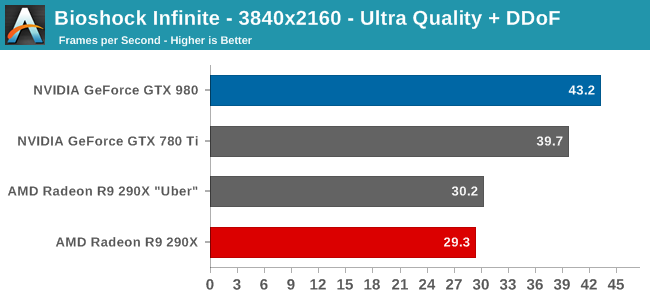
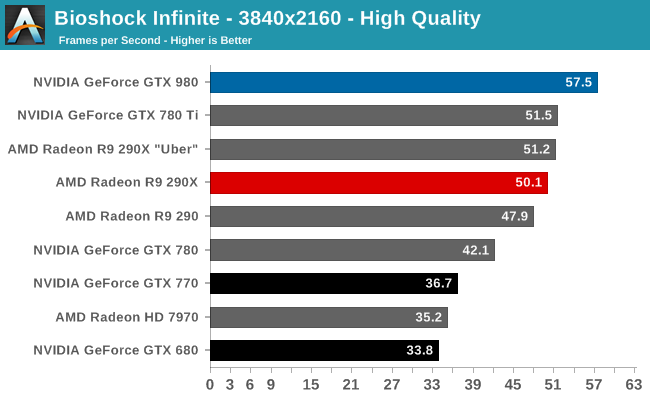
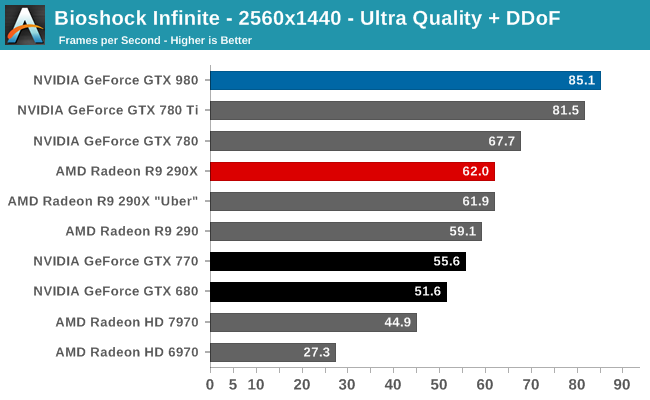
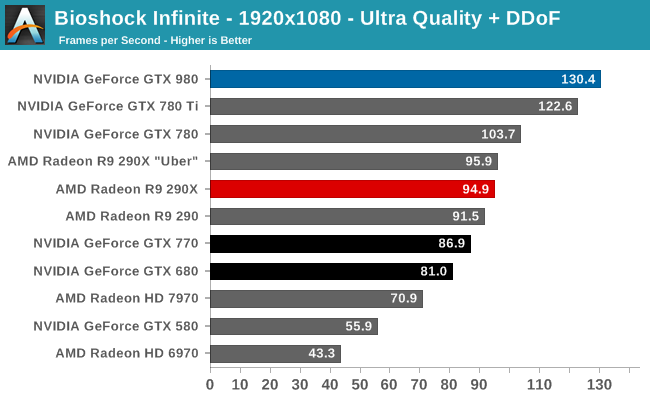
Even with advanced depth of field effects, our highest end video cards are starting to run away with Bioshock: Infinite. That is particularly true for the GTX 980, which in a game that NVIDIA frequently does well in further props up the GTX 980’s advantage. Only at 4K are the R9 290XU and GTX 980 anywhere near close, otherwise at 1440p it’s a 37% performance advantage. GTX 780 Ti on the other hand holds much closer, still falling behind the GTX 980 but only by around 5% at sub-4K resolutions. This does make for a good moment for showcasing the GTX 980’s greater ROP throughput though; as we crank up the resolution to 4K, the 780 Ti falls further behind, especially when we’re at lower quality settings that leave us less shader-bound.
On an absolute basis 120Hz/144Hz gamer should have a blast even with a single GTX 980 at 1080p, while purists will need more performance for 1440p than the 85fps the card can offer. And at 4K the GTX 980 is doing very well for itself, almost cracking 60fps at High quality, and becoming the only card to crack 40fps with Ultra quality.
This will be one of the weaker showings for the GTX 980 over the GTX 680 though; at sub-4K resolutions it’s only a 60-65% performance improvement.


Meanwhile Bioshock is the first of 5 games we can reliably measure with the FCAT tools to check for frame pacing consistency. Bioshock is a bit more erratic than most games in this respect, and while our general rule of thumb for an excellent performance from a single card is 3%, our recording for GTX 980 is a bit higher at 3.5%. On the other hand at 4K it measures in at just 2.3%. So while frame pacing is going to be a bit of a rubber stamping process overall, we can confirm that GTX 980 is delivering a good frame pacing experience in Bioshock.


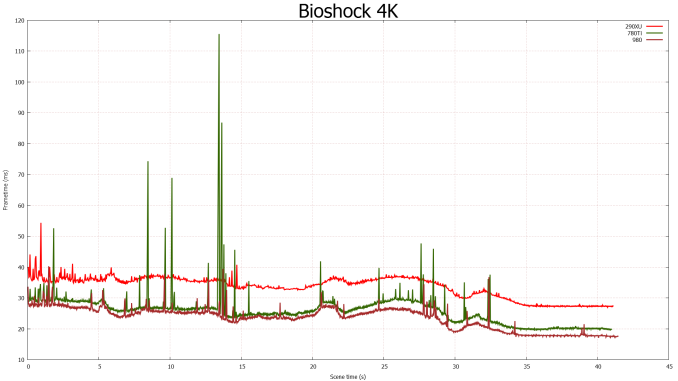








274 Comments
View All Comments
Frenetic Pony - Friday, September 19, 2014 - link
This is the most likely thing to happen, as the transition to 14nm takes place for intel over the next 6 months those 22nm fabs will sit empty. They could sell capacity at a similar process to TSMC's latest while keeping their advantage at the same time.nlasky - Friday, September 19, 2014 - link
Intel uses the same Fabs to produce 14nm as it does to produce 22nmlefty2 - Friday, September 19, 2014 - link
I can see Nvidia switching to Intel's 14nm, however Intel charges a lot more than TSMC for it's foundry services (because they want to maintain their high margins). That would mean it's only economical for the high end cardsSeanJ76 - Friday, September 19, 2014 - link
What a joke!!!! 980GTX doesn't even beat the previous year's 780ti??? LOL!! Think I'll hold on to my 770 SC ACX Sli that EVGA just sent me for free!!Margalus - Friday, September 19, 2014 - link
uhh, what review were you looking at? or are you dyslexic and mixed up the results between the two cards?eanazag - Friday, September 19, 2014 - link
Nvidia would get twice as many GPUs per wafer on a 14nm process than 28nm. Maxwell at 14nm would blow Intel integrated and AMD out of the water in performance and power usage.That simply isn't the reality. Samsung has better than 28nm processes also. This type of partnership would work well for Nvidia and AMD to partner with Samsung on their fabs. It makes more sense than Intel because Intel views Nvidia as a threat and competitor. There are reasons GPUs are still on 28nm and it is beyond process availability.
astroidea - Friday, September 19, 2014 - link
They'd actually get four times more since you have to considered the squared area. 14^2*4=28^2emn13 - Saturday, September 20, 2014 - link
Unfortunately, that's not how it works. A 14nm process isn't simply a 28nm process scaled by 0.5; different parts are scaled differently, and so the overall die area savings aren't that simple to compute.In a sense, the concept of a "14nm" process is almost a bit of a marketing term, since various components may still be much larger than 14nm. And of course, the same holds for TSMC's 28nm process... so a true comparison would require more knowledge that you or I have, I'm sure :-) - I'm not sure if intel even releases the precise technical details of how things are scaled in the first place.
bernstein - Friday, September 19, 2014 - link
no because intel is using their 22nm for haswell parts... the cpu transition ends in a year with the broadwell xeon-ep... at which point almost all the fabs will either be upgraded or upgrading to 14nm and the rest used to produce chipsets and other secondary die'snlasky - Saturday, September 20, 2014 - link
yes but they use the same fabs for both processes